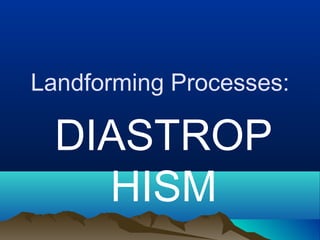Diastrophism
- 2. Stress and Strain •Stress is force acting on rock •Strain is rock’s response to stress When a rock is subjected to stress, it deforms and is said to strain. A strain is a change in size, shape, or volume of a material. Uniform Stress – is a stress wherein all the forces act equally from all directions Differential Stress – occurs when stress acting on the rock is not equal in all directions
- 3. Tensional stress (or extensional stress) – stress which stretches rock Compressional stress – stress which squeezes rock Shear stress – stress which results in slippage and translation Three Kinds of Differential Stress
- 5. 1. Folds 2. Faults Types of Deformation WhenTypes of Deformation When Rocks are Subjected to StressRocks are Subjected to Stress
- 6. FOLDING • Compressional stress causes rocks to buckle and fold – Anticline: arch-shaped fold – Syncline: sink-shaped fold
- 7. Anticlines begin as ridges Synclines begin as valleys
- 9. FAULTING • Rock is strained beyond ability to remain intact; rock fractures; one side is displaced with respect to the other . Fault plane: surface along which 2 sides move Fault scarp: cliff formed along fault face
- 11. The two sides of a non- vertical fault are known as the hanging wall and footwall. hanging wall occurs above the fault plane footwall occurs below the fault
- 12. Types of FAULTS 1. Normal Fault - results from extensional stress - vertical movement along an inclined fault plane
- 14. HORST and GRABENHORST and GRABEN (result of normal faulting)(result of normal faulting) Graben down-faulted block Horst up-faulted block
- 16. 2. Reverse Fault - results from compressional stress - Vertical movement along inclined fault plane such that one side rides up over the other. - often creates landslides
- 18. 3. Thrust fault - reverse fault with very low angle - more horizontal than vertical movement
- 20. 4. Transform(Strike-slip) Fault - horizontal movement; no fault scarp
- 22. 5. Oblique-slip faults - have both a vertical and horizontal component of motion along the fault - adjacent points on different sides of the fault have moved up or down and back or forward relative to each other. They are essentially a combination of strike-slip and dip-slip motion.





















